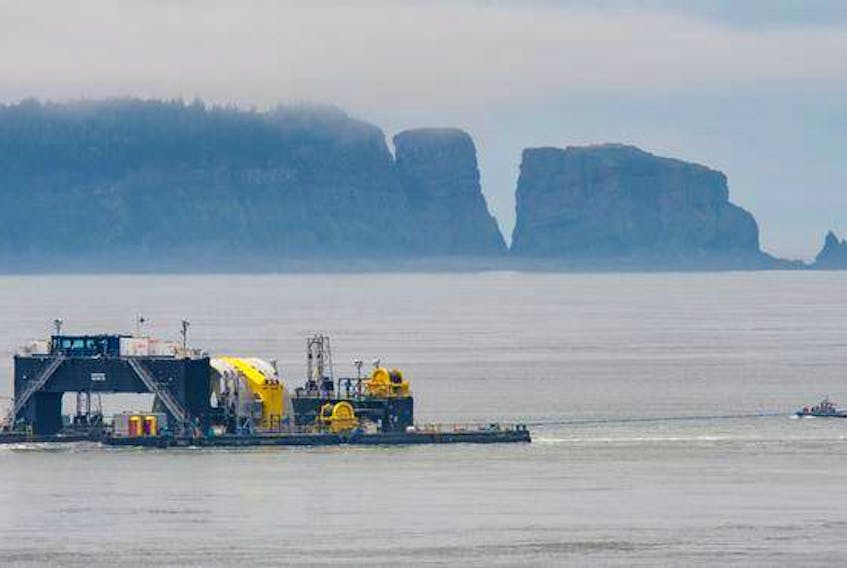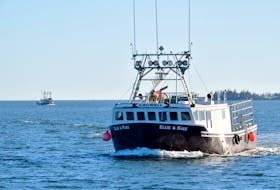Emera is withdrawing from its ownership stake in Cape Sharp Power as the latter falls in violation of the Fisheries Act.
On Monday the parent company of Nova Scotia Power told OpenHydro and its provisional liquidator that it is withdrawing from its involvement in Cape Sharp Tidal.
Emera owned 20 per cent of Cape Sharp Tidal, which itself owns a 1,000-tonne instream tidal turbine placed in the Minas Passage last month. A week after its deployment the company which owns the other 80 per cent – Ireland-based OpenHydro – was forced into receivership.
Many local contractors – from marine services companies to motel operators – went unpaid as a result of the bankruptcy.
“We are in the process of examining our rights and obligations under our various commercial agreements with OpenHydro,” reads a statement released Monday by Emera.
“… Without support from the technology developer, OpenHydro, to operate and maintain the technology and the turbine, we do not believe that there is further value in pursuing this project for our business.”
With one owner in receivership and the other walking away from its ownership stake, some fishermen in the area are questioning who is responsible for the 16-metre diameter tidal turbine spinning in the Minas Passage.
“If we hurt anything – a salmon or anything – we get fined,” said Gerry Taylor a Parrsboro fisherman whose weir is near the site of the turbine.
“To us, (Emera) is just trying to wash their hands of it so they’re not responsible.”
It took three months last year to remove a different version of the turbine for testing.
It’s not clear whether there are funds available to pay for its removal again.
Emera spokeswoman Stacey Pineau said that will fall to OpenHydro’s liquidator, Grant Thornton.
“We understand that the provisional liquidator currently controls the majority interest of OpenHydro Technology in Cape Sharp Tidal and is responsible for decisions related to the operations and future of OpenHydro and its respective subsidiaries,” said Pineau.
“Emera has repeatedly reinforced with Grant Thornton the need to continue environmental monitoring and safe operation of the deployed turbine and the importance of meeting all obligations of Cape Sharp Tidal and OpenHydro to local suppliers. It is our understanding that a number of local suppliers have been paid and we will continue to encourage the provisional liquidator to resolve all outstanding items as soon as possible.”
Meanwhile, the turbine is spinning but not generating electricity and the monitoring equipment placed aboard to determine its effect on the marine life that migrates through the Minas Passage is not operating.
As part of a special dispensation granted to Cape Sharp Tidal by Fisheries and Oceans Canada, a contingency plan has to be implemented to monitor its effect on marine life within two weeks of the turbine’s installation.
That two weeks was up last Wednesday.
“As Cape Sharp Tidal has not complied with conditions of its Fisheries Act Authorization related to environmental monitoring, DFO is evaluating appropriate actions,” reads a written response by Fisheries and Oceans Canada spokesman Stephen Bornais on Monday.
The turbine occupies one of four berths at the Fundy Research Centre for Energy near Parrsboro where instream tidal technology is tested as a method for generating electricity.
FORCE spokesman Tony Wright said the turbine’s owner – in this case Cape Sharp Tidal – is responsible for monitoring their equipment.
“Presently we are urging for the implementation of the approved program or contingency plans as soon as possible,” said Wright.
“We’ve also been commissioned to conduct additional turbine-specific monitoring activities at the request of Cape Sharp Tidal – that work is ongoing now.”
For his part, Taylor is worried for the future of his weir with no companies claiming responsibility for the nearby turbine.
“They do what they want, then nobody wants responsibility,” said Taylor.
“That’s why we don’t trust any of them.”









